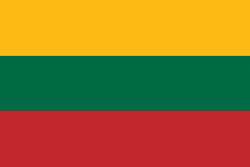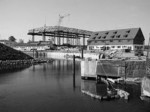
Lithuania
| Full Name | 41 Republic of Lithuania | |
| Alliance | Neutral or Non-Belligerent | |
| Entry into WW2 | 15 Jun 1940 | |
| Population in 1939 | 2,442,000 | |
| Military Deaths in WW2 | 25,000 | |
| Civilian Deaths in WW2 | 300,000 | |
| - Civ Deaths from Holocaust | 135,000 |
Contributor: C. Peter Chen
ww2dbaseLithuania became an independent country in 1918, after the fall of the Russian Empire. In 1926, following the tensions built up by the signing of the Soviet–Lithuanian Non-Aggression Pact, a coup d'état by the political party Lithuanian Nationalists Union, political party Lithuanian Christian Democrats, and the military installed Antanas Smetona as the President and Augustinas Voldemaras as the Prime Minister. Smetona dissolved the parliament in May 1927, put down an uprising later in the same year, and dismissed Voldemaras in 1929, all acts that would secure his power base, which ultimately helped him remain in power until Jun 1940. When the Nazi Party came to power in Germany, it organized agitators in Lithuania. In 1934, Lithuania arrested and tried about 100 Nazi activists, which led to a German embargo of Lithuanian products, which harmed Lithuania economy and destabilized domestic politics. In Mar 1938, Poland demanded the resumption of diplomatic relations (which had been broken in 1920), threatening with invasion otherwise; Lithuania submitted to Polish demands as its military was weaker and it failed to gather international support. Adolf Hitler, who had wanted to annex Klaipeda region (German: Memelland), which had formerly been a part of Germany, prepared the German Army for its occupation should Poland invade Lithuania, but such an invasion did not take place. Failing to get this opportunity, Germany chose to simply threaten with military force, with Lithuania again submitted; the loss of Klaipeda eroded Smetona's authority, which forced him to form a coalition government. When the European War began in Sep 1939, Soviet forces captured Wilno, Poland (Lithuanian: Vilnius), which was a historical Lithuanian city. Lithuania made a successful petition to Moscow requesting for its return into Lithuanian borders, in returning allowing 20,000 Soviet troops to be stationed in the region, not knowing that Germany and the Soviet Union had already made aggression plans against Lithuania. After a series of increasingly more demanding threats, Lithuania ultimately gave in to the Soviet Union in Jun 1940. The subsequent annexation of Lithuania into the Soviet Union was considered to be illegal by the international community, but condemnations resulted in little. Administered by Justas Paleckis and Vladimir Dekanozov's puppet government, Soviet-occupied Lithuania, 20,000 to 30,000 people who were deemed dangerous to Soviet rule were deported by the Soviet NKVD to labor camps in Central Asia, many of whom would never return. Lithuanian culture, whose rebuilding had made significant gains since the country's restoration in 1918, was systematically destroyed by the Soviets. Meanwhile, the Lithuanian currency was artificially devalued in an effort to create a total dependency on the Soviet Union. When Germany turned on its former ally the Soviet Union, Soviet troops fell back from Lithuania to more defensible positions, massacring between 1,000 to 1,500 Lithuanians on their way out. As the German troops entered the country, Lithuanians initially regarded them as liberators, but German design on Lithuania was gradually revealed, starting with the lack of support for the Lithuanian provisional government, followed by the establishment of Reichskommissariat Ostland and the banning of Lithuanian political parties. Much like in other German-occupied nations in this period, elements for and against the German occupation both existed. Many minority political parties already established as anti-Semitic, for example, collaborated with the Germans in the atrocities committed against Lithuanian Jews and in the resettlement (and thus Germanization) of Lithuanian lands. Prior to the European War, Lithuania was home to about 155,000 Lithuanian Jews; after the fall of Poland in 1939, the number grew to over 200,000 with the influx of Polish Jews. During the German occupation, between 130,000 and 143,000 Lithuanian Jews were lost (some estimates ran as high as 195,000), making Lithuania one of the greatest victims of the Holocaust both in terms of number of deaths and percentage of Jewish population lost. Resistance movements generally picked up momentum in between 1942 and 1943; they were generally Soviet-backed and operated in eastern Lithuania. The Polish Home Army (Armia Krajowa) resistance force also operated in eastern Lithuania, under the notion that Wilno was illegally taken by the Soviet Union from Poland and it would be returned to Poland after the war. In the summer of 1944, Soviet troops reached eastern Lithuania. As Soviet troops drove across the country, Lithuania saw a great amount of destruction in the bitter fighting. The Soviet re-conquest of Lithuania was complete in early 1945, and mass deportations would resume shortly after. Between 1944 and 1953, nearly 120,000 people, or about 5% of the population, would be deported. Little different than what the Germans had done during its occupation, the Soviet Union resettled non-Lithuanians (mostly Russians) from elsewhere in the Soviet Union in an attempt to integrate Lithuania into the Soviet Union. The Lithuanian Soviet Socialist Republic, which had never been recognized by the West (as the annexation of 1940 was considered illegal), was dissolved at the end of the Cold War in 1990, and the Republic of Lithuania was restored.
ww2dbaseSource: Wikipedia
Last Major Update: Jul 2014
| Events Taken Place in Lithuania | ||
| Annexation of Klaipeda | 22 Mar 1939 | |
| Annexation of the Baltic States | 15 Jun 1940 - 9 Aug 1940 | |
| Operation Barbarossa | 22 Jun 1941 - 30 Sep 1941 | |
| Discovery of Concentration Camps and the Holocaust | 24 Jul 1944 - 29 Apr 1945 | |
| Facilities | ||
| Lindenau GmbH Schiffswerft und Maschinenfabrik | Shipyard | |
Photographs
 |  |  |
Lithuania in World War II Interactive Map
Please consider supporting us on Patreon. Even $1 per month will go a long way! Thank you. Please help us spread the word: Stay updated with WW2DB: |
Visitor Submitted Comments
7 May 2022 10:54:44 AM
Interessante
All visitor submitted comments are opinions of those making the submissions and do not reflect views of WW2DB.
- » Wreck of M-49 Found (10 Apr 2025)
- » Japanese Emperor Visited Iwoto (Iwo Jima) (8 Apr 2025)
- » Race, Holocaust, and African-American WW2 Histories Removed from the US Naval Academy Library (7 Apr 2025)
- » US Government Plans to Purge WW2 Information (17 Mar 2025)
- » See all news
- » 1,167 biographies
- » 337 events
- » 44,606 timeline entries
- » 1,243 ships
- » 350 aircraft models
- » 207 vehicle models
- » 376 weapon models
- » 123 historical documents
- » 261 facilities
- » 470 book reviews
- » 28,501 photos
- » 365 maps
George Patton, 31 May 1944
Please consider supporting us on Patreon. Even $1 a month will go a long way. Thank you!
Or, please support us by purchasing some WW2DB merchandise at TeeSpring, Thank you!
22 Apr 2020 02:04:25 AM
Nice